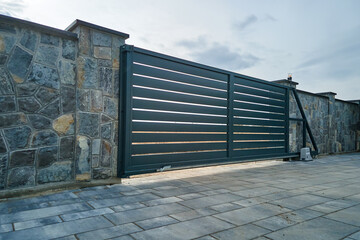House Fence Repair
A rusted picket or two is one thing, but a fence that has rotted through could require more than a little TLC. It can also cost much more, especially if it’s a metal or vinyl fence. The big question is whether or not it’s time to replace the entire thing. Generally, anything beyond superficial damage points to replacement.

Replacing a damaged fence post is relatively straightforward and shouldn’t require any professional assistance at Summerville Fence Repair. Begin by assessing the situation to determine if there is acute damage, such as a tree falling on the fence, or whether the problem is chronic and will continue to get worse (like wood rot). It’s also worth noting if the post is leaning and needs bracing or if it can be fixed by simply resetting it.
If the fence post is simply leaning, you can use a pair of scrap two-by-fours to support it. Make sure the two-by-fours are attached to the existing post and firmly in place, then set the new post in its hole. It’s important to ensure the new post is placed in the exact center of the hole, as this is vital for proper support. Then, once the post is in place and firmly secured with wood screws, backfill it with soil or concrete. If you choose to use concrete, it’s recommended that you first place a layer of gravel in the bottom of the hole and then add the concrete mix. Be sure to pour the concrete so that it extends slightly above ground level to help prevent water from pooling around the post and causing further problems.
When it comes to repairing a broken fence post that is set in concrete, you will need several tools to handle the project, including a heavy-duty sledgehammer and an angle grinder with a masonry blade attachment. Start by tapping around the base of the concrete with the sledgehammer to loosen it. Then, using the grinder, cut away the damaged portion of the concrete until it is removed completely. Once the concrete is removed, you can then re-set the post.
It’s recommended that you use a fast-setting concrete mix when you are fixing a broken fence post that is set in cement. You can find this type of concrete at most hardware stores or home improvement centers. Be sure to follow the directions on the packaging exactly for best results. Also, when resetting a damaged fence post, be sure to use wood screws that are corrosion-resistant and take the time to thoroughly inspect your repair work for signs of damage before reattaching any panels or rails.
Structural Damage
Whether it’s wood, metal, wrought iron, vinyl, bamboo, or some other material, fences are subject to structural damage from extreme weather conditions such as high winds and raging rainstorms. Some of this damage is repairable, while other damage may be permanent.
Structural damage to a fence can take several forms, from small areas of rust that need to be sanded down and painted to widespread warping of wooden boards. If you notice a problem with your fence that requires a more substantial repair or replacement, it’s generally a good idea to contact a professional fencing company as soon as possible.
A reputable fence repair contractor should be familiar with the regulations that must be followed when doing any repairs or replacement work on your yard. This includes contacting the underground utility companies to have all of your property lines marked. Failure to do this can result in thousands of dollars worth of damages if you hit a water, gas, or electrical line while doing fence work.
Many homeowners are unsure of their responsibility when it comes to the maintenance and repair of a fence that runs on a property line between two different home owners. A simple check with your HOA or reading through any contracts or agreements that you have with your neighbors should clarify any confusion about this issue.
Even if your house fence is in relatively good condition, you still should consider contacting a repair professional if you have more than 30% of it in disrepair. This 30% rule generally applies to any type of fence, and it’s a good rule of thumb to follow when determining if you should repair or replace your fence.
As previously mentioned, a fence is a major investment, and it’s important to keep up with maintenance and repair as needed to protect your investment. A rotting and deteriorating fence is not as appealing to potential home buyers as a well-maintained and attractive one, so it’s best to act on any problems as soon as they are noticed. Contacting a Keller fence expert is an excellent option, as they can assess the situation and make recommendations that are both effective and cost-efficient.
Damaged Panels
Whether they’re made of wood, PVC, metal, or another material, fences are exposed to a wide range of damage. This can include acute damage, such as a tree falling on a panel or a car backing into the fence, as well as chronic damage, such as termites and wood rot.
Sometimes a new coat of paint or stain is enough to fix fence panels that have sustained damage. But other times, it’s necessary to replace the entire panel. This is usually true for damaged panels that are beyond repair due to severe weather, animal activity, or age-related damage.
Replacing a damaged fence panel isn’t a simple task. It’s a good idea to work with a professional for this type of project. They can ensure that all the components are compatible with one another and help you choose the right color or material for your fence replacement. In addition, a professional can usually finish the job much more quickly than a DIYer, which can save you both time and money.
If you’re working with wood, it’s best to pressure wash the new panel before installing it. This helps to remove dirt, moss, mildew, and any other debris from the surface of the wood. Once it’s dry, you can then apply an oil-based wood stain or sealant. This will protect the wood from the elements and help it last longer.
Before you begin to repair any broken sections of your fence, it’s important to check the condition of the posts. This is because a single weakened post can ruin an entire section of the fence. Make sure that your posts are sunk into the ground at least three feet, or use gravel or concrete for additional strength.
In general, repairing or replacing a fence is cost-effective when the damage is minor and not likely to get worse. However, it’s not always worth the effort to repair a fence that is going to deteriorate in the future. In these cases, it may be more cost-effective to replace the entire fence and start fresh. Replacing a fence will also give you the opportunity to upgrade to more durable or attractive materials.
Damaged Rails
If your fence posts and rails are intact, but your fence boards have become warped or damaged for some reason, you can repair them with wood filler or putty. But if the damage is severe, a new board or rail may be in order. If you have a split-rail fence, you may also need to replace a section of rotten or broken rail.
Natural disasters are the most dramatic agent of fence destruction, but rot, animals and even weed whackers can take their toll on a well-built structure. Mike Sludock, owner of Massachusetts-based Walpole Woodworkers, recently inspected fences around a new Cape home that had been severely damaged by a falling tree. He replaced many of the pickets, posts and rails.
If a slat of your fence’s top rail becomes damaged, you can usually mend it by hammering two pieces of scrap 2×4 directly under the damaged section with galvanized nails or metal T-braces. If the rail itself is rotted, however, you’ll need to replace it entirely. To do this, dig out the rotted or split rail with a post hole digger and remove it from the ground. Dig down a few inches in each post where the rail was attached and use a rounded-end shovel to widen the hole and lift the post up.
To replace a damaged rail, first locate precisely where the damaged section of the rail begins and ends, then identify the spots where the rail attaches to the fence with wire sections. Untwist the wires and pull the rail from the fence. Dig out the remaining section of the post if necessary and replace it with a new post, backfilling with tamped soil or gravel.
To replace a bent section of fence rail, you’ll need lineman’s pliers, a reciprocating saw and a replacement section of railing with a coupling sleeve. Cut the ends of the new section of railing with your saw, then slip the sleeve onto one end of the damaged section. Then slide the sleeve onto the other end of the new section and crimp it into place with your pliers.
